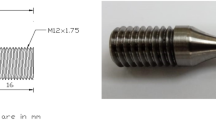Conclusions
-
1.
The characteristics of static and cyclic strength of titanium alloys VT22 and VT37 with solid-solution hardening are 20–25% higher than in high-temperature alloys with intermetallic hardening.
-
2.
The use of titanium alloys VT22 and VT37 instead of the traditional high-temperature alloys (VT3-1, VT-6) for the production of large disks and engine blades serving at 300–350°C makes it possible to reduce their mass by 20–25%.
Similar content being viewed by others
References
V. N. Moiseev, “Main directions in the development of titanium alloys for modern machine building,”Metalloved. Term. Obrab. Met., No. 7, 30–34 (1977).
Author information
Authors and Affiliations
Additional information
Translated from Metallovedenie i Termicheskaya Obrabotka Metallov, No. 2, pp. 34–36, February, 2000.
Rights and permissions
About this article
Cite this article
Moiseev, V.N. High-strength titanium alloys for large parts of aircraft engines. Met Sci Heat Treat 42, 81–83 (2000). https://doi.org/10.1007/BF02469872
Issue Date:
DOI: https://doi.org/10.1007/BF02469872




